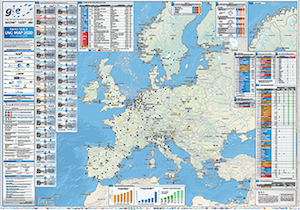Infrastructures for Liquefied Natural Gas (LNG) are continuing to develop strongly throughout Europe whether as fuel in maritime and heavy road transport or as off-grid energy solution.
For road transport, the existing trend has been confirmed: there are now about 280 LNG fuelling stations in operation, while the milestone of the 200th station was reached just one year ago.
For ships bunkering, the progress is even more striking: there are now 9 vessels dedicated to LNG bunkering, with 5 more expected to be delivered by the end of 2020, while three years ago there were only 2.
Supplying industrial sites not connected to the gas grid is another expanding major usage of small scale LNG.
All these usages are benefitting from the development of versatile small scale infrastructure. They expand the geographic availability of small scale LNG onshore, on inland waterways or at sea. Related services are now or will soon be available in nearly all large scale terminals, new projects of small scale LNG terminals and small scale liquefaction plants are also developing in more and more countries.
Last but not least, an additional step allowing the energy transition has been taken: liquid biomethane production plants are developing in several European countries (Norway, Sweden, Italy, UK, Finland…).
LNG has great potential for replacing heavy fuel oil and diesel in freight transport and shipping, as well as in supply to industrial sites and communities not connected to a pipeline network. This is thanks to the LNG superior environmental performance. Indeed, LNG has a much smaller carbon footprint and switching to LNG brings an immediate benefit on air quality and therefore health:
• up to 25% less CO2;
• up to 90% less nitrogen oxide (NOx);
• negligible quantity of sulphur and fine particulates.
Moreover, all LNG infrastructures are “carbon neutral ready” : they can immediately manage, without any limitation, liquid biomethane (which is already happening) or synthetic methane (i.e. methanated green hydrogen), or can adapt to other carbon neutral molecules.
Arno Büx, GLE President: “In order to support its development, GIE continuously provides up-to date information on the state and use of Europe’s LNG infrastructure. With the publication of the 2020 GIE small scale LNG map, GIE confirms its commitment to providing information, expertise and transparency tools to the European institutions, the regulatory bodies, the market and any other stakeholders. The rapid growth of small scale LNG illustrates its potential to pave the way to a greener energy future.”


